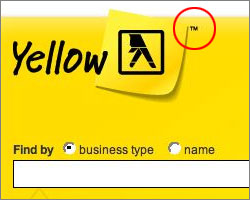Sensis, the Telstra subsidiary that owns things like the Yellow Pages and Trading Post, has kicked off a legal attack on small websites for “trademark infringement”. Why? Because they haven’t got an ® after every mention of “Yellow Pages”.
Apart from the daftness of attacking little fish, which only makes your company look like a bully, you’ve got to wonder why they’re doing it.
- They’re re-branding as “Yellow” anyway. yellowpages.com.au identifies itself as “yellow.com.au”, and their new logo just says “Yellow”. Here’s a screenshot of their site as of a few minutes ago.
- There doesn’t seem to be any actual trademark infringement. At least not by my reading of some material I’ll mention shortly.
I found out about this yesterday when Professor Roger Clarke posted to the Link mailing list. I’ve become more and more astounded at the stupidity of it all as I’ve read people’s comments…
Professor Clarke says:
I am requested to:
— “use the [R inside a circle] symbol next to the trade mark …”;
— “use the name of the product as a noun (eg “the Yellow Pages
[R inside a circle] Directory”.
He points out that the web page in question receives bugger all traffic, and observes:
I find it absolutely extraordinary that [Sensis] would fund a partner in a law firm to waste time and money searching out harmless pages and writing ‘nastygrams’ of this kind — energy that could instead be invested in improvements to the product.
Note that the use of the term on the page is quite general, and there is no evidence of any attempt to appropriate the term, nor to benefit commercially or otherwise from its use, nor to denigrate the IP owner. In fact it promotes your site, and speaks in a complimentary manner about it. Under the circumstances, the letter is not only inappropriate, but oppressive.
Apart from this bullying, it would appear that there aren’t actually grounds for Sensis to complain. According to the Arts Law Centre of Australia (quoting IP Australia, who handle trademark registration)…
To be successful in an infringement action it is necessary to show that:
- use of the infringing mark was use as a trade mark. That is, the infringing trade mark was being used to indicate a connection, in the course of trade, between goods or services and the (infringing) trader or service provider; and
- the infringing trade mark is identical, substantially identical or deceptively similar to your trade mark; and
- the goods or services (or both) in relation to which the infringing trade mark was used are the same or at least similar or closely related to the goods or services for which your trade mark is registered.
Professor Clarke’s mention of Yellow Pages doesn’t fit any of those criteria!
Rick Welykochy dug up an example of Sensis’ “nastygram” [PDF file], and Eric Scheid found another stroppy recipient of Sensis’ legal largesse.
In my opinion, and I am not a lawyer, Sensis probably wants to generate consistency in the way people use their product name. But instead of asking nicely, they’re using aggressive, bullying language and implied legal threats. The reaction, naturally enough, is “Screw you!”
I recently moved my landline phone from Telstra to iiNet and bundled it with ADSL2+. A couple of weeks later, a Telstra rep phoned to ask, “Is there anything we can do to get you back?”
My reply was, “No. Because it’s not about the service or the price. It’s because I don’t want to do business with an organisation that’s run by a pack of arseholes. Please make sure that specific message is passed up the line.”
This Sensis attack on small website owners is exactly the sort of thing I’m talking about.
[Update: I’ve just thought of a possible reason. Sensis want to separate “the Yellow Pages Directory” from the Yellow brand, possibly with the aim of offloading the presumably-expensive business of printing phone books which no-one uses any more.]


In our case Telstra was unhappy for me to use the generic term ‘yellow pages’ as synonym for a directory of people. In the knowledge management field it’s common practice to refer to your yellow pages directory as a list of your employees and their details (phone numbers, location, who reports to who). In fact IBM call its internal directory Blue Pages. I would have thought Telstra would support this type of generic use just like saying “Google it” when you mean search it, Hoover it when you mean vacuum it, or grab the Esky even when it’s not an Esky.
@Shawn Callahan: Thanks for that background information. According to Wikipedia (and a hat-tip to David Lochrin):
I had a look at IP Australia yesterday and, yes, the trademarks “yellow pages” and “electronic yellow pages” and “talking yellow pages” are registered to Telstra. Nowhere can I see “the Yellow Pages directory” as a registered trademark — though I’m a novice at trademark searches.
Many trademark-holders do not want their marks to become generic, since that would allow “lesser-quality products and services” to trade on the “good name” of the “better brand”. Presumably that’s what was happening in your case.
As I understand trademark law, if you don’t actively defend against infringements then that can be used as a defence. However I am not a lawyer.